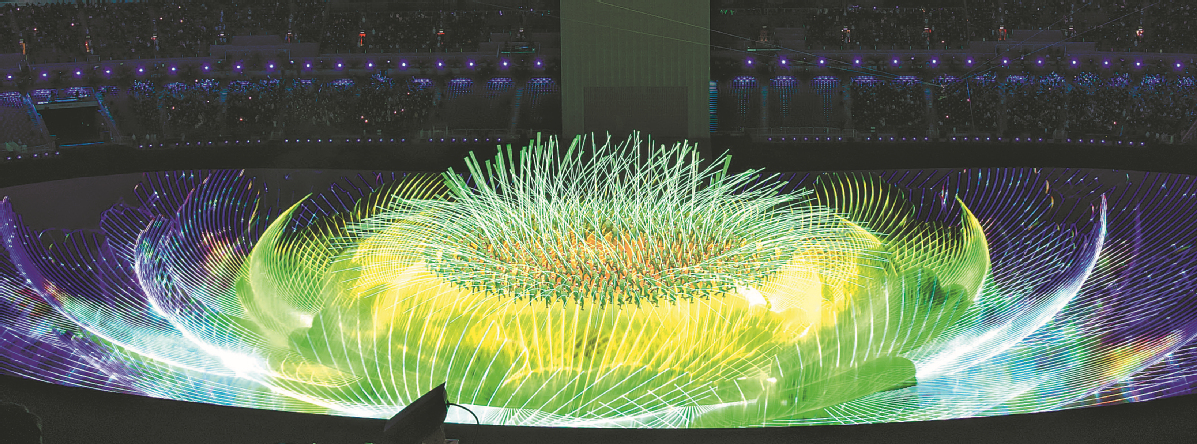Charm of Chinese Art: Interrelations between Emptiness and Substantiality

Chen Jingwen
A clump of green grass suddenly appeared on the pitch-black field. And with the rhythm of the music, the blades of grass opened and swirled, representing the breath of flowers, the wheat waves of green grass, and then turned into white dandelions, drifting with the wind. This is the first program at the opening ceremony of the 2022 Beijing Winter Olympics, symbolizing the newborn grass with simple and abstract flexible rods, expressing Chinese people’s expectation for spring. Similarly, the design of the emblem of the Winter Olympics is also intriguing.
“Winter Dream” takes the Chinese character “winter” as its inspiration source, combines the abstract slideway, the posture of ice and snow movement with traditional calligraphy, and expresses Chinese people’s understanding of the Olympic spirit to the world with simple symbols. Being “succinct but not simple”, a series of wonderful winter Olympic designs remind us of a common expression method in Chinese art — the interrelations between emptiness and substantiality. Symbolizing infinite spiritual meaning with limited reality, simple emptiness can reach infinite things and convey the realm of Chinese artistic beauty. With regard to the emptiness and substantiality in Chinese art, Mr. Zong Baihua has an essay “Emptiness and Substantiality in Chinese Artistic Expression” in his book Aesthetic Walk, which discusses the ins and outs of the concept of emptiness and substantiality in detail.
Mr. Zong Baihua pointed out at the beginning that “emptiness” and “substantiality” are the two basic aesthetic standards of Chinese art. “Substantiality” means richness and universality. With substantiality in art, there is extensive and substantial realistic content. “Emptiness” refers to generalization and refinement. With emptiness in art, there is the spiritual height after removing the rough and extracting the fine. Only by dialectical unity of “emptiness” and “substantiality” can artistic expression be completed and artistic beauty be formed.
However, “emptiness” and “substantiality” are contradictory. Since we cannot cover all the contents if we want to discard the dross and select the essential, and it seems that we cannot reach a high degree of generalization if we want to cover all the contents. Then, how does Chinese art achieve “the combination of emptiness and substantiality?” Zong Baihua put forward a concept, that is, “realism in Chinese art tradition”. This realism is different from naturalism, which reproduces reality like a camera, and also different from formalism, which abandons content and is obsessed with abstraction. Its essence is “interrelations between emptiness and substantiality”, that is, through highly symbolic models, it reflects a wide range of reality beyond models. For example, to draw a dragon, it is not necessary to draw the whole body of it but to draw the scales and claws exposed in the clouds, and the whole dragon can be seen immediately, thus achieving the realm of emptiness and substantiality.
Starting from the creative method of combining emptiness and substantiality, Mr. Zong Baihua further extended to the way of dealing with space in Chinese art. Different from western art, which uses the science-center perspective to understand the world, the “emptiness and substantiality” realm of Chinese art comes from the Chinese people's most fundamental worldview. Ancient Chinese philosophy holds that the universe is a rhythm of life consisting of one yin and one yang, one emptiness and one substantiality, and it is a combination of emptiness and substantiality. Therefore, the emptiness of the picture is not nothing in geometry, but the possibility of creating everything in the void. Therefore, Chinese artists can always see the infinity from the finiteness, and return to the finiteness from the infinity, with not forever but endless interest.
Zong Baihua’s view is that Chinese art, in the vision of such a world view, is completely different from scientific western art. Because of the transformation between emptiness and substantiality, it pays more attention to conception and verve; and with the help of the coexistence of emptiness and substantiality, it freely goes in and out between spirit and material, swims between heaven and earth, and observes everything with a self-satisfied spirit. It is this unique feeling about the universe and the world that has contributed to the Chinese art of the interrelations between emptiness and substantiality, and it is this kind of Chinese art that in turn becomes the window for us to know the Chinese worldview.
Looking back at the artistic design of the Beijing Winter Olympics, and looking back at the virtual and real art that can be seen everywhere in our life, it seems that we have a better understanding of the intention behind these designs, and thus see the artistic realm of Chinese people.
Chen is associated with School of Culture & Communication, Shandong University, China.
Recent News

Do not make expressions casting dout on election: EC
14 Apr, 2022
CM Bhatta says may New Year 2079 BS inspire positive thinking
14 Apr, 2022
Three new cases, 44 recoveries in 24 hours
14 Apr, 2022
689 climbers of 84 teams so far acquire permits for climbing various peaks this spring season
14 Apr, 2022
How the rising cost of living crisis is impacting Nepal
14 Apr, 2022
US military confirms an interstellar meteor collided with Earth
14 Apr, 2022
Valneva Covid vaccine approved for use in UK
14 Apr, 2022
Chair Prachanda highlights need of unity among Maoist, Communist forces
14 Apr, 2022
Ranbir Kapoor and Alia Bhatt: Bollywood toasts star couple on wedding
14 Apr, 2022
President Bhandari confers decorations (Photo Feature)
14 Apr, 2022











